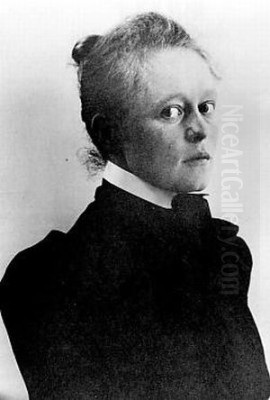
Helene Schjerfbeck stands as one of Finland's most significant and revered modern painters. Her long career, spanning from the late 19th century well into the mid-20th century, witnessed a remarkable artistic evolution, moving from academic realism through naturalism and impressionistic phases to a highly personal, reductive, and psychologically profound modernism. Known particularly for her haunting self-portraits and sensitive depictions of women and children, Schjerfbeck forged a unique path, often in relative isolation, creating an oeuvre that continues to resonate with its emotional depth and stylistic innovation.
Early Life and Artistic Awakening
Helena Sofia Schjerfbeck was born on July 10, 1862, in Helsinki, Finland, which was then an autonomous Grand Duchy within the Russian Empire. Her parents were Svante Schjerfbeck, an office manager, and Olga Johanna Printz. Tragedy struck early in Helene's life. At the age of four, in 1866, she suffered a fall that resulted in a fractured hip. The injury never fully healed correctly, leaving her with a permanent limp and lifelong physical challenges that impacted her mobility. This physical limitation, however, seemed to channel her energies towards observation and inner reflection.
Her artistic talent was evident from a young age. Recognizing her potential, her father provided her with drawing materials. Despite the family's modest means, and perhaps partly due to her inability to attend regular school because of her injury, her artistic inclinations were nurtured. A pivotal moment came when Adolf von Becker, a respected Finnish painter and art teacher, recognized her exceptional abilities.
Thanks to von Becker's intervention and support, Schjerfbeck was enrolled, at the remarkably young age of eleven (in 1873), in the Finnish Art Society's Drawing School in Helsinki. Her talent was so apparent that the school waived her tuition fees. She studied diligently under instructors including von Becker himself, absorbing the academic principles of drawing and painting prevalent at the time. Her early works already showed promise, and she began exhibiting with the Finnish Art Society as early as 1879.
Parisian Years and Broadening Horizons
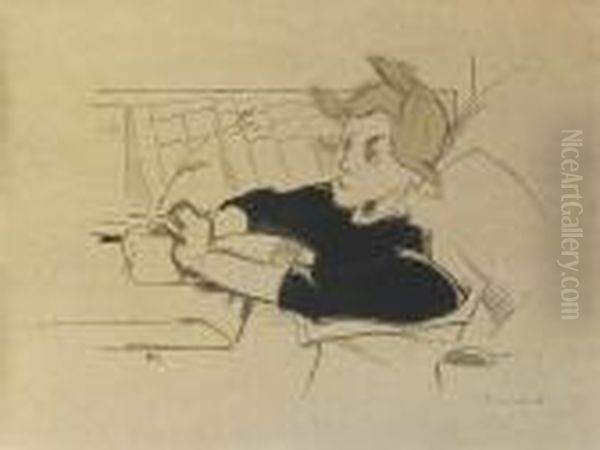
Like many ambitious artists of her generation, Schjerfbeck sought further training and exposure in Paris, the undisputed centre of the art world in the late 19th century. Around 1880, supported by a grant from the Imperial Russian Senate, she travelled to France. In Paris, she immersed herself in the vibrant artistic milieu, studying at renowned private ateliers like the Académie Colarossi. There, she received instruction from artists such as Gustave Courtois and Raphaël Collin. She also spent time studying under Léon Bonnat, known for his portraiture.
During this period, Schjerfbeck absorbed the influences of French Realism, particularly the work of painters like Jules Bastien-Lepage, who advocated for truthful depictions of rural life and ordinary people. Her technique became more refined, and her subject matter expanded. She travelled within France, spending time in Brittany, a popular destination for artists seeking picturesque scenery and authentic local culture.
A significant early success came with her painting Wounded Warrior in the Snow (1880), a historical scene executed with realistic detail and sombre tones, reflecting her academic training but also hinting at a deeper emotional resonance. This work garnered attention back in Finland. Another important work from this period is The Convalescent (1888), depicting a child recovering from illness, which won a bronze medal at the 1889 Paris World Exposition (Exposition Universelle). This painting, with its tender observation and delicate handling of light, became one of her most beloved images.
Schjerfbeck also travelled to Pont-Aven in Brittany and later, in 1887, to St Ives in Cornwall, England. In these artist colonies, she interacted with other painters, including the Finnish artists Helena Westermarck and Maria Wiik, who became lifelong friends. She also formed a close artistic relationship with the English painter Marianne Preindlsberger (later Marianne Stokes) and her husband Adrian Stokes. The light and atmosphere of these coastal regions, particularly St Ives, influenced her palette, leading to brighter tones and a looser brushwork, hinting at an engagement with Impressionist ideas, though she never fully adopted the style.
Return to Finland and the Path to Modernism
Upon returning to Finland in the 1890s, Schjerfbeck worked for a time as an instructor at the Finnish Art Society's Drawing School, the very institution where she had begun her studies. However, teaching did not entirely suit her temperament, and health issues often interfered. This period also saw her undertake commissions to copy Old Master paintings in St. Petersburg, Vienna, and Florence. This engagement with the works of masters like El Greco and Fra Angelico proved formative, not in terms of direct imitation, but in deepening her understanding of composition, form, and emotional expression.
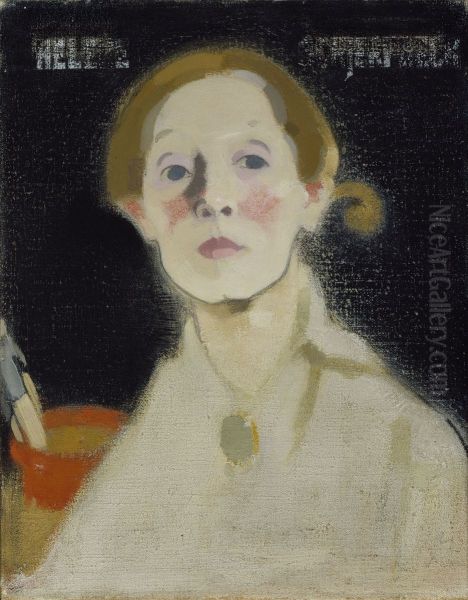
Gradually, Schjerfbeck began to move away from the detailed naturalism of her earlier work. Influenced by international trends like Symbolism and Synthetism, associated with artists like Paul Gauguin, and the radical simplification seen in the works of James McNeill Whistler and Édouard Manet, she started to pare down her compositions. She focused increasingly on essential forms, subtle colour harmonies, and the evocation of mood over precise representation.
Her paintings from the turn of the century show a growing interest in flattened perspectives, strong outlines, and a more subjective use of colour. Works like The Door (1884), though earlier, already showed her interest in simplified forms and psychological spaces. Later works intensified this direction. She began exploring subjects that allowed for this reductive approach: quiet interiors, still lifes, and increasingly, portraits where the sitter's inner state was paramount.
The Hyvinkää Period: Isolation and Artistic Focus
In 1902, seeking tranquility and needing to care for her aging mother, Olga, Schjerfbeck moved away from the Helsinki art scene to the small town of Hyvinkää, about 50 kilometers north of the capital. This marked the beginning of a long period of relative isolation that would last for decades. While she maintained contact with the art world through correspondence and occasional exhibitions, her daily life became increasingly withdrawn, centred around her home, her mother, and her art.
This withdrawal, however, coincided with a period of intense artistic development and the emergence of her mature, modernist style. Freed from the pressures and expectations of the capital's art circles, she pursued her unique vision with greater focus. Her paintings became increasingly simplified and abstract. She reduced her subjects to their essential elements, using a limited palette, subtle tonal variations, and expressive lines to convey profound psychological depth.
During the Hyvinkää years, she produced some of her most iconic works. Silence (1907) exemplifies this phase, with its stark composition and enigmatic mood. She frequently painted local people, particularly women and children, as well as still lifes composed of simple objects. Her technique involved layering paint, scraping it back, and allowing the texture of the canvas or board to play a role, creating surfaces that are both delicate and materially present.
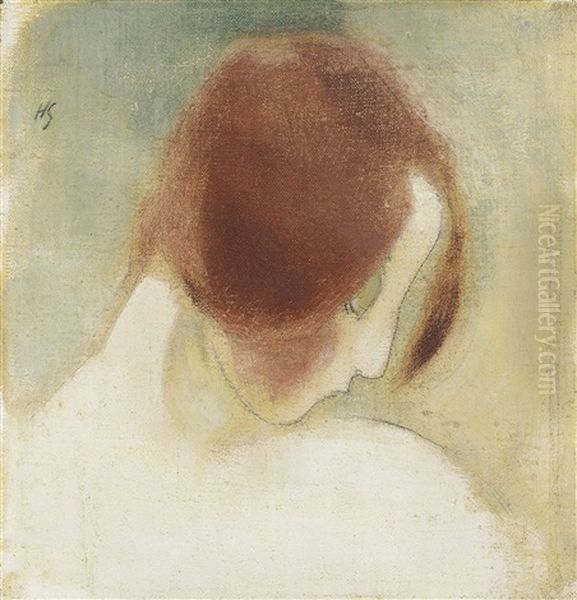
Crucial support during this time came from the art dealer Gösta Stenman, who began promoting her work actively around 1913, organizing exhibitions in Finland and Sweden. Another important figure was Einar Reuter (also known as H. Ahtela), a forester and art collector who became a devoted friend and champion. Reuter encouraged her modernist tendencies, wrote about her work, and facilitated connections, sharing reproductions of works by international modernists like Paul Cézanne, Vincent van Gogh, and Edvard Munch, whose approaches to form, colour, and emotional expression resonated with her own explorations.
The Ekenäs Years and Late Abstraction
Following her mother's death in 1923, Schjerfbeck moved in 1925 to Ekenäs (Tammisaari), a coastal town in southern Finland. She continued to live a secluded life, dedicating herself almost entirely to her painting. Her style continued to evolve towards greater abstraction and psychological intensity. The self-portrait became an increasingly central genre during these later decades.
From around 1915 onwards, Schjerfbeck had embarked on a remarkable series of self-portraits that would continue until the end of her life. These works are unflinching explorations of her own aging process, physical decline, and inner state. Early self-portraits show a recognizable likeness, but as the series progresses, the forms become increasingly fragmented, mask-like, and abstract. She used herself as a readily available model, but these paintings transcend mere likeness to become profound meditations on identity, mortality, and the passage of time.
Her palette often became bolder in some works, while others relied on incredibly subtle nuances of grey, black, and ochre. The application of paint could be thin and veil-like or built up in textured layers. Works like Self-Portrait with Black Background (1915) and the various iterations of The Red-Haired Girl show her moving towards bolder simplification and expressive colour. Later self-portraits from the 1930s and 1940s push this reduction even further, sometimes dissolving the features into near-abstract patterns of line and tone.
Her still lifes from this period are similarly reductive and powerful. Simple objects – a piece of fruit, a vase, textiles – are transformed into compelling studies of form, colour, and light, imbued with a quiet intensity. She often revisited motifs, exploring their formal possibilities in series, much like Giorgio Morandi would do, though with a distinct psychological undercurrent.
Wartime and Final Years in Sweden
The outbreak of the Winter War between Finland and the Soviet Union in 1939, and the subsequent Continuation War, disrupted Schjerfbeck's quiet life in Ekenäs. For safety and due to her declining health, she moved to Sweden in 1944. She spent her final years at the Saltsjöbaden spa hotel near Stockholm.
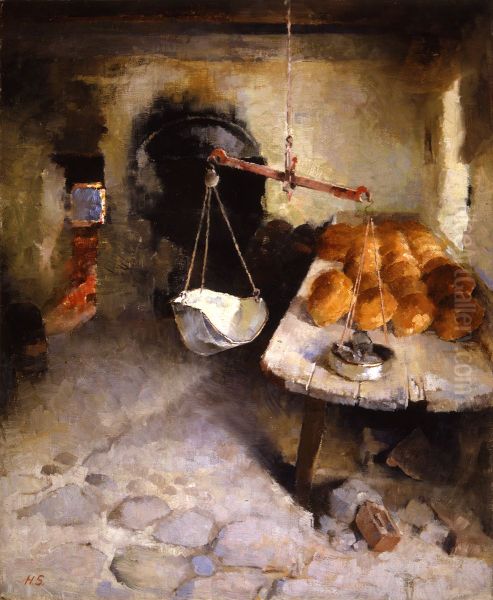
Despite her age and frailty, this period saw a final, astonishing burst of creativity. Confined mostly to her room, she produced a series of stark, haunting self-portraits. These final images, painted in the last year of her life, are among her most radical and moving works. Reduced to essential, almost skeletal lines and ghostly washes of colour, they confront mortality with extraordinary honesty and artistic power. They represent the culmination of her lifelong quest for essential form and psychological truth.
Helene Schjerfbeck died at Saltsjöbaden on January 23, 1946, at the age of 83. She left behind an estimated 730 paintings, along with numerous drawings and watercolours.
Artistic Style and Techniques
Schjerfbeck's artistic journey is one of constant refinement and distillation. Starting with a foundation in 19th-century academic realism, she absorbed influences from Naturalism and Impressionism during her time abroad. Key figures whose work she admired or engaged with included Whistler, Manet, Cézanne, Gauguin, and Munch. She was also receptive to the aesthetic principles of Japanese Ukiyo-e prints, evident in her flattened perspectives and emphasis on line.
Her mature style is characterized by radical simplification and reduction. She stripped away non-essential details to focus on form, line, and subtle colour relationships. Her compositions are often sparse and carefully balanced, creating a sense of quietude and introspection. She had a masterful command of tone, often working within a restricted palette to achieve profound emotional effects.
Her technique was experimental and varied. She worked in oil, watercolour, gouache, charcoal, and pencil. She often prepared her canvases or boards meticulously, sometimes using underpainting or coloured grounds. She employed techniques like scraping, sanding, and layering thin washes of paint to create complex, textured surfaces that contribute significantly to the expressive power of her work. The material presence of the paint and the support is often an integral part of the image.
Key Themes and Subjects
While Schjerfbeck painted landscapes, particularly earlier in her career, her primary focus was on the human figure and still life. Her most significant contributions lie in her portraits and self-portraits. She possessed an extraordinary ability to capture the inner life of her subjects, often conveying complex emotions through subtle means – the turn of a head, the gaze of the eyes, the posture of the body.
Women and children were frequent subjects, depicted with sensitivity and empathy. Works like The Convalescent, The School Girl II (1908), and various portraits of local women reveal her deep interest in female identity and experience. She avoided sentimentality, instead imbuing her figures with a sense of dignity and quiet strength.
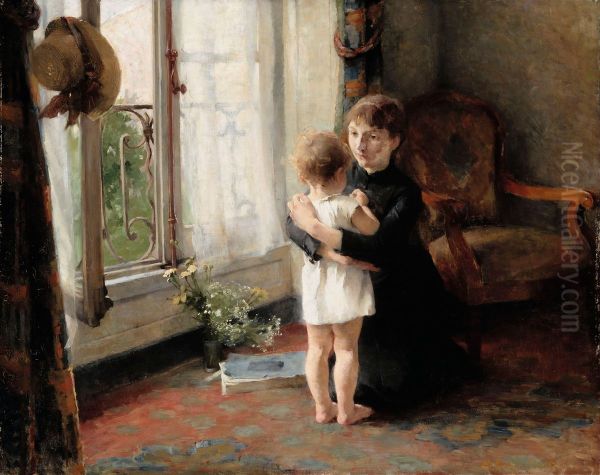
The self-portraits form a unique and powerful body of work within her oeuvre. Spanning several decades, they document her physical aging but, more importantly, serve as a relentless exploration of the self, mortality, and the human condition. They stand comparison with the self-examinations of Rembrandt or the later self-portraits of artists like Käthe Kollwitz.
Still life provided another avenue for her formal and expressive concerns. Mundane objects were transformed through her reductive vision into potent symbols or purely formal arrangements, exploring shape, colour, and texture with intense focus. Themes of time, fragility, memory, and silence pervade much of her work, regardless of the specific subject matter.
Relationships and Contemporaries
Despite her periods of isolation, Schjerfbeck was not entirely cut off from the art world. Her early friendships with Helena Westermarck and Maria Wiik provided companionship and artistic exchange. Her relationship with Adolf von Becker was foundational to her education. Her time in Paris and St Ives brought her into contact with international artists like Marianne and Adrian Stokes.
The support of Einar Reuter and Gösta Stenman was crucial in her later career, providing encouragement, promotion, and a connection to broader artistic developments. Through them, she engaged intellectually with the work of major modernists like Cézanne, Munch, and Van Gogh, even from her seclusion.
Within the Finnish context, she stands alongside other key figures of the "Golden Age" of Finnish art, such as Akseli Gallen-Kallela and Magnus Enckell, though her path diverged significantly towards a more introspective and distinctly modern idiom. While contemporaries like Gallen-Kallela focused on national romantic themes drawn from the Kalevala epic, Schjerfbeck pursued a more personal and universal psychological modernism. She can also be situated within a broader Nordic context, sharing certain sensibilities with Munch or Vilhelm Hammershøi, yet retaining her unique voice.
Legacy and Influence
Helene Schjerfbeck is now widely recognized as one of the most important figures in Finnish art history and a significant modernist painter in the Nordic region. While her international reputation grew more slowly, particularly outside Scandinavia, major retrospectives in cities like Paris, London, Frankfurt, and Tokyo in recent decades have brought her work to a wider global audience.
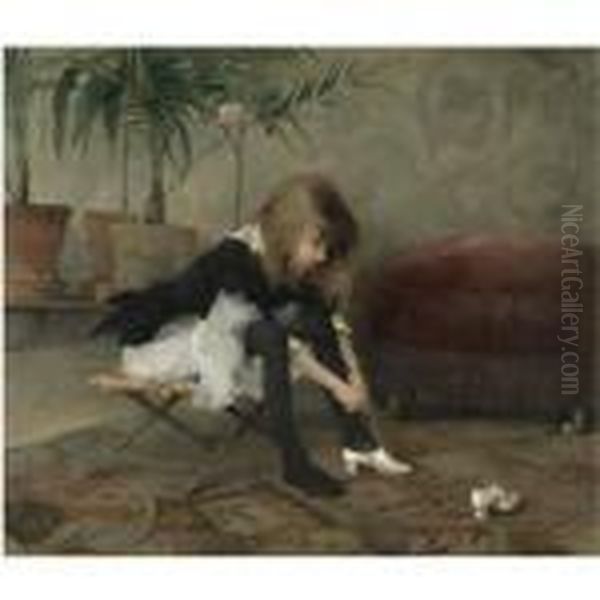
Her influence lies in her uncompromising artistic vision, her technical innovation, and the profound psychological depth of her work. Her relentless self-portraits, in particular, have resonated with later generations of artists interested in self-representation and the exploration of identity, including figures like Lucian Freud and Antony Gormley, who have acknowledged her impact.
Her journey from academic realism to a radical, personal modernism serves as a compelling example of artistic integrity and development. She demonstrated how an artist, even working in relative isolation, could engage with international currents while forging a highly original path. Her focus on reduction, essential form, and emotional resonance anticipated aspects of later 20th-century art.
In Finland, her status is iconic. Her work is held in major museum collections, and she is celebrated as a pioneer, particularly as a female artist who achieved prominence in a male-dominated field through sheer talent and perseverance. The issuance of a commemorative 2 Euro coin in 2012, marking the 150th anniversary of her birth, signifies her enduring national importance.
Conclusion
Helene Schjerfbeck's art offers a quiet yet powerful counterpoint to some of the more extroverted movements of modernism. Her life, marked by physical challenges and periods of withdrawal, fueled an art of intense introspection and refinement. Through her sensitive portraits, haunting self-portraits, and reductive still lifes, she explored the complexities of the human psyche, the passage of time, and the search for essential form. Her unique blend of technical mastery, emotional depth, and modernist sensibility ensures her enduring place as a major figure in European art. Her paintings continue to speak with a quiet intensity, revealing the profound beauty and psychological depth that can be found in the observed world and the inner self.